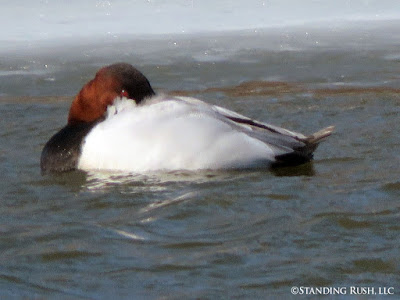A new month meant sustained cold. Only 10 of the 28 days got above freezing and most of those were on the front end of February. Lows were routinely in the teens or single digits, and we even dipped below zero on a few occasions. While we speculated whether we'd even get "walking ice" or a sustained stretch of "real winter," both ultimately came -- and in earnest.
 |
| Toledo tied an all-time record with 19 inches of snow on the ground on February 18, 2021. Most of that was thanks to a single event that brought more accumulation in a single snowfall than any other in my life's history (even more than the fabled "Blizzard of '78"). |
Most of our attention turned to planning for the upcoming field season. But even as the marsh froze solid, there were tons of opportunities to see the strong pulse of life alive amongst a persistent blanket of snow and ice.
 |
| Big ducks (mainly mallards with a few pintails) rise above a mostly frozen early February marsh to a rising sun and a setting moon. |
 |
| "Our eagles" start to show consistent nesting behaviors in the massive tangle they have carefully constructed in the cottonwood next to the estuary. |
 |
| It must be even colder up there in that seemingly constant wind. |
 |
Pretty hard to miss the nest (or even the protruding head/s of eagles) from afar
(as always, click to enlarge). |
 |
| Despite sometimes biting cold, Roy never misses the opportunity to take advantage of conditions to keep the place up. Here, brush mowing helps to maintain dikes and access while not interfering with nesting songbirds. |
 |
| Even a stark haircut will grow back fast, but it keeps large, potentially destructive trees from getting established on dike slopes and it also gives visual evidence of spots that need special attention. |
 |
| We were able to take advantage of a completely frozen dike and a few thousand residual dollars in an open grant to carry on the erosion protection we started last August. |
 |
| This work took place to augment the installation and operation of Structure 2, could be squeezed in between major snowfalls, and can be tidied up as needed this coming summer (although something tells me Roy will find a way to get it done before then). |
 |
| During the coldest of the cold, Roy spent a couple days exploring with his camera. His finds are worth highlighting here (including this active seep on the edge of the West Marsh, a groundwater spring that remained open all day and night despite temperatures well below zero). |
 |
| Roy caught these candid shots of a coyote crossing over the south dike with a snowy package of mystery meat -- maybe a muskrat? -- being downwind with lots of fresh snow must have helped keep Roy "concealed" from the distracted canine. |
 |
| Coyotes are plentiful at Standing Rush (as evidence from our active trail cameras), but it's not very often we even catch a glimpse during broad daylight. |
 |
| A couple cool shots of another common (but largely nocturnal) mammal of the marsh. |
 |
| Even in bitter cold, moving water near Structure 1 kept small areas open with shad (in beak above) swimming beneath. This made for some distant (and therefore grainy) images of canvasbacks. |
 |
| Speaking of grainy, we're still yet to get a good crisp image of one of my favorite marsh birds, the "marsh hawk" or northern harrier. Roy saw individuals scanning the fresh snow on several occasions. |
 |
| Unfortunately for this mouse, it was oblivious both of Roy and of the dangers lurking from above. Maybe it was distracted by the sub-zero temps that had it out feeding in the sun when this image was captured. |
 |
| Roy's return to the same vicinity the next day gave evidence that the mouse (or at least a mouse) and the marsh hawk (or a marsh hawk) were "introduced." (Click to enlarge) |



















